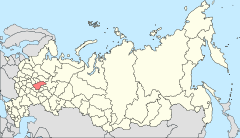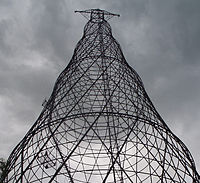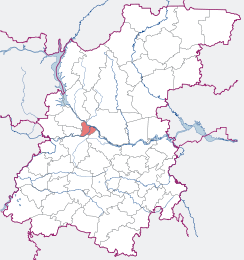- Dzerzhinsk, Russia
-
For other places with the same name, see Dzerzhinsk.
Dzerzhinsk (English)
Дзержинск (Russian)- City[citation needed] - 
Location of Nizhny Novgorod Oblast in RussiaCoordinates: 56°14′N 43°27′E / 56.233°N 43.45°ECoordinates: 56°14′N 43°27′E / 56.233°N 43.45°E Coat of arms City Day Last Sunday of May[citation needed] Administrative status Country Russia Federal subject Nizhny Novgorod Oblast Municipal status Urban okrug Dzerzhinsk Urban Okrug[citation needed] Mayor[citation needed] Viktor Sopin[citation needed] Representative body City Duma[citation needed] Statistics Area 219.92 km2 (84.91 sq mi)[citation needed] Population (2010 Census,
preliminary)240,762 inhabitants[1] - Rank in 2010 77th Population (2002 Census) 261,334 inhabitants[2] - Rank in 2002 72nd Density 1,095 /km2 (2,840 /sq mi)[3] Time zone MSD (UTC+04:00)[4] Founded 1929[citation needed] Previous names Rastyapino (until 1929)[citation needed] Postal code(s) 606000—606039[citation needed] Dialing code(s) +7 8313[citation needed] Official website Dzerzhinsk (Russian: Дзержи́нск) is a city in Nizhny Novgorod Oblast, Russia, situated along the Oka River, about 400 kilometers (250 mi) east of Moscow. Population: 240,762 (2010 Census preliminary results);[1] 261,334 (2002 Census);[2] 285,071 (1989 Census).[5]
The city is named after Feliks Edmundovich Dzerzhinsky, a Polish Bolshevik leader who was the first head of the Cheka (secret police).
Modern-day Dzerzhinsk is a large center of the Russian chemicals production industry. In the past, the city was also among Russia's principal production sites for chemical weapons. Owing to its strategic significance, this city was until recently officially closed to foreign visitors.
Contents
Chemical weapons and other production
Manufacture of a number of chemical weapons started in 1941, particularly concentrating on the production of lewisite - the poisonous effects of which are owed to its arsenic trioxide content — and yperite (mustard gas). The factory producing these substances was called the Kaprolactam (or Caprolaktam) Organic Glass Factory, and in addition to its arsenic-based weapons, also produced prussic acid and phosgene.
Chemical weapons production at Dzerzhinsk ceased in 1965. Some materials were transferred to storage units, while large amounts of waste material — frequently containing high concentrations of arsenic - were buried in dumps on the site of the factory. Full dismantling of the yperite facility was commenced in 1994. As of 1998, the lewisite production unit was still not completely disassembled.
As of 2008, Dzerzhinsk has thirty-eight large industrial enterprises, which export their goods worldwide. About one thousand varieties of chemical products are produced in Dzerzhinsk. The largest factories, which presently exist or existed in the past, include:
- Sverdlov Plant, FSE (Federal State Enterprise) manufactures munitions, battle and industrial explosives, and chemicals for industrial purposes (phenol-formaldehyde resin, epoxy resin, carbamide-furane resin, plasticizers, hardeners of various modifications, nitrobenzene, sulphanole, acetic anhydride, various cleaners and detergents, as well as other products). The plant is included in the presidential list of the country's strategic enterprises. This is Dzerzhinsk's largest factory.
- Korund, JSC (opened in 1915, the first factory in Russia to produce cyanide, still operational). This plant produces corundum for lasers and other applications. It is the oldest enterprise in Dzerzhinsk. In 2004, the plant was temporarily closed due to bankruptcy.
- Kaprolaktam, JSC. After having been transformed into a manufacturer of chemicals equipment, hydrochloric acid, ethylene oxide, polymer pellicle, and plastic products, it is now associated with NORSI (Nizhny Novgorod Orgsintes) Orgsteklo group. Over $15 million was invested into this joint venture by Wella AG, a German personal care products company. The output includes soaps, acrylic glass, and car parts.
- Dzerzhinskhimmash, JSC (opened in 1941, currently makes distillation and сolumn equipment, evaporators, heat exchangers).
- Sintez, JSC. Produces acetone, carbonyl iron, diethanolamine, isopropanol, methylamine, phenol, etc.
- Orgsteklo, JSC (previously manufactured specialist glass for the aeronautics market, currently specializes in production of acrylic co-polymers and organic glasses).
- Avangard-KNAUF, JSC
- Liebherr, JSC
- Plastik, JSC
- Aviabor, JSC
- Sibur-Nevtechim, JSC
- Oka, Yava, Orgsitilen, Zarya (no longer functioning).
Pollution
According to September 12, 2007, study by Blacksmith Institute (United States), Dzerzhinsk is one of the worst polluted cities of the world and has a life expectancy of 42 years for men and 47 for women, with the 2003 death rate exceeding its birth rate by 260%.[6] Environmental action groups such as Greenpeace attribute such low life expectancy to high levels of persistent organic chemicals, particularly dioxins. Blacksmith Institute also names sarin, lewisite, sulfur mustard, hydrogen cyanide, phosgene, lead, and organic chemicals among the worst pollutants.[6] Parts of Dzerzhinsk's water are contaminated with dioxins and phenol at levels that are reportedly seventeen million times the safe limit.[6]
Dzerzhinsk's environmental agency estimates that almost 300,000 tons of chemical waste were dumped in the city between 1930 and 1998.[citation needed] The Ecology Committee of the Russian State Duma also considers Dzerzhinsk among the top ten cities with disastrous ecological conditions.[7]
Dzerzhinsk City Administration, however, asserts that the Blacksmith Institute report is false, stating, for example, that since sarin had never been produced in the city, it cannot be one of the major pollutants. Also, according to the city Health Department, average life expectancy in the city was 64 years in 2006. Askhat Kayumkov, the head of the Dront public ecological organization, which was quoted as a source by Blacksmith Institute, states that his organization never provided Blacksmith Institute with data of any kind. Furthermore, he does not believe that Dzerzhinsk is one of the most polluted cities in Russia, much less in the whole world.[8]
Additionally, a 2000 audit report by the Audiekometal organization, based in Moscow, asserts that for the past ten years Dzerzhinsk has not made it to the top ten most polluted cities of the Russian Federation, and that the level of pollution in the city is moderate.[citation needed]
In the end, however, despite the ecological situation in the city being at its best in the past eighty years (mostly due to bankruptcies and closures of the polluting factories), several locations in the city pose a tangible ecological risk. These sites include the landfill, toxic waste burial grounds, and a so-called "white sea," composed of disposed chemical wastes.[9] These sites are kept under constant ecological monitoring.
Sights
The unique architectural construction – the 128 m steel lattice hyperboloid tower built by the Soviet engineer and scientist Vladimir Grigorievich Shukhov in 1929 is located near the town of Dzerzhinsk on the left bank of the Oka River.
 Shukhov tower on the Oka River near Dzerzhinsk
Shukhov tower on the Oka River near Dzerzhinsk
Demographics
- Births (2008): 2,584
- Deaths (2008): 4,438
Notable people
- Irina Voronina, Playboy Playmate of the Month[10]
International relations
Main article: List of twin towns and sister cities in RussiaTwin towns/sister cities
Dzerzhinsk is twinned with the following sister cities:[11]
In Russia
- Maloyaroslavets
- Ivanovo
- Gus Khrustalny
- Ozery
- Soligalich
- Zarechny
- G.Gubkin
- Belomorsk
Abroad
 Berkovitsa, Bulgaria
Berkovitsa, Bulgaria Bitterfeld, Germany
Bitterfeld, Germany L'Eliana, Spain
L'Eliana, Spain Krasnoperekopsk, Ukraine
Krasnoperekopsk, Ukraine Marmaris, Turkey
Marmaris, Turkey Montana, Bulgaria
Montana, Bulgaria
References
- ^ a b Федеральная служба государственной статистики (Federal State Statistics Service) (2011). "Предварительные итоги Всероссийской переписи населения 2010 года (Preliminary results of the 2010 All-Russian Population Census)" (in Russian). Всероссийская перепись населения 2010 года (All-Russia Population Census of 2010). Federal State Statistics Service. http://www.perepis-2010.ru/results_of_the_census/results-inform.php. Retrieved 2011-04-25.
- ^ a b Федеральная служба государственной статистики (Federal State Statistics Service) (2004-05-21). "Численность населения России, субъектов Российской Федерации в составе федеральных округов, районов, городских поселений, сельских населённых пунктов – районных центров и сельских населённых пунктов с населением 3 тысячи и более человек (Population of Russia, its federal districts, federal subjects, districts, urban localities, rural localities—administrative centers, and rural localities with population of over 3,000)" (in Russian). Всероссийская перепись населения 2002 года (All-Russia Population Census of 2002). Federal State Statistics Service. http://www.perepis2002.ru/ct/doc/1_TOM_01_04.xls. Retrieved 2010-03-23.
- ^ The value of density was calculated automatically by dividing the 2010 Census population by the area specified in the infobox. Please note that this value may not be accurate as the area specified in the infobox does not necessarily correspond to the area of the entity proper or is reported for the same year as the population.
- ^ Правительство Российской Федерации. Постановление №725 от 31 августа 2011 г. «О составе территорий, образующих каждую часовую зону, и порядке исчисления времени в часовых зонах, а также о признании утратившими силу отдельных Постановлений Правительства Российской Федерации». Вступил в силу по истечении 7 дней после дня официального опубликования. Опубликован: "Российская Газета", №197, 6 сентября 2011 г. (Government of the Russian Federation. Resolution #725 of August 31, 2011 On the Composition of the Territories Included into Each Time Zone and on the Procedures of Timekeeping in the Time Zones, as Well as on Abrogation of Several Resolutions of the Government of the Russian Federation. Effective as of after 7 days following the day of the official publication).
- ^ "Всесоюзная перепись населения 1989 г. Численность наличного населения союзных и автономных республик, автономных областей и округов, краёв, областей, районов, городских поселений и сёл-райцентров. (All Union Population Census of 1989. Present population of union and autonomous republics, autonomous oblasts and okrugs, krais, oblasts, districts, urban settlements, and villages serving as district administrative centers.)" (in Russian). Всесоюзная перепись населения 1989 года (All-Union Population Census of 1989). Demoscope Weekly (website of the Institute of Demographics of the State University—Higher School of Economics. 1989. http://demoscope.ru/weekly/ssp/rus89_reg.php. Retrieved 2010-03-23.
- ^ a b c "The top most polluted places". Blacksmith Institute. http://www.blacksmithinstitute.org/site10g.php.
- ^ Дзержинск вошел в десятку наиболее неблагополучных с экологической точки зрения территорий РФ – Косариков (Dzerzhinsk Makes It to the Top Ten Most Ecologically Adverse Cities of the Russian Federation) (Russian)
- ^ «Дзержинский репортёр». «Кто "заказал" Дзержинск»? Официальная критика присутствия Дзержинска списке Института Блэксмита (Dzerzhinsky Reportyor newspaper. Official criticism of the inclusion of Dzerzhinsk into the Blacksmith Institute list) (Russian)
- ^ «Живые здесь не ходят». Газета "RE:акция", №43ц 11-21 декабря 2006 г. (The Living Do Not Walk Here. "RE:aktsiya" newspaper, #43, December 11, 2006 – December 21, 2006) (Russian)
- ^ Irina Voronina page on IMDB
- ^ Sister cites Dzerzhinsk
External links
- Official server of Dzerzhinsk municipality
- Chamber of Commerce and Industry of Dzerzhinsk
- Dzerzhinsk City Information Portal
- Information server All Dzerzhinsk
Cities and towns in Nizhny Novgorod Oblast Administrative center: Nizhny Novgorod
 Categories:
Categories:- Cities and towns in Nizhny Novgorod Oblast
- Cities and towns built in the Soviet Union
- Populated places established in 1929
Wikimedia Foundation. 2010.


